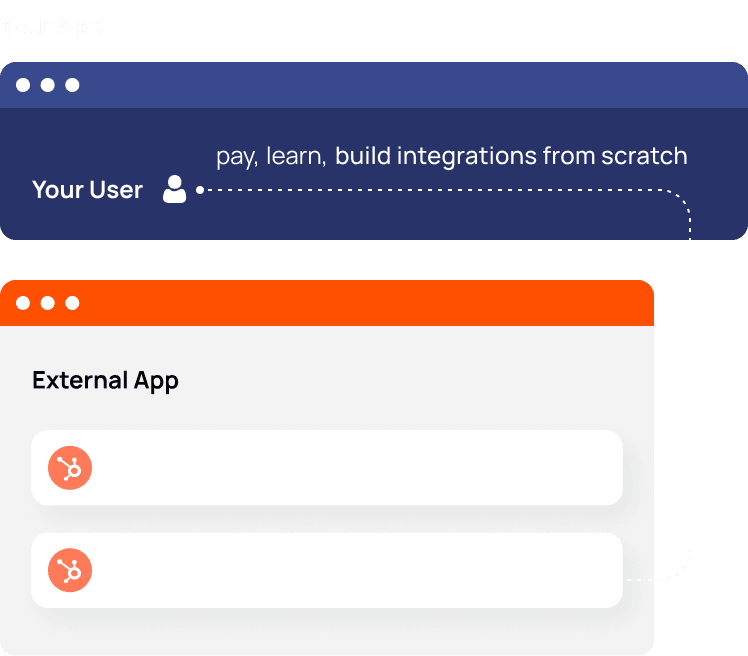
Integration.app vs Zapier: why infrastructure beats tooling when it comes to building for customers
If you’re evaluating tools to power your product’s integrations, it’s tempting to lump Integration.app into the same category as Zapier. After all, they both “do integrations,” right?
Not quite.
Zapier is a powerful automation tool – but it was never designed to power external integrations inside your own product. If you’re a startup or a growing company looking to offer native integrations to your customers, Zapier is not the tool for the job. Here’s why Integration.app is a completely different platform – and why the distinction matters.
Zapier Is Built for End Users. Integration.app Is Built for Product Teams.
Zapier was made for individuals and teams who want to automate their own workflows across different tools. Think: “When I get an email in Gmail, save the attachment to Dropbox.”
Integration.app is made for companies who want to offer integrations to their own customers – embedded inside their SaaS product. Think: “My customers should be able to connect Salesforce, Shopify, or Slack natively from inside my app.”
If you’re building a product and want your integrations to feel seamless and native, you shouldn’t ask your users to log into a third-party tool, drag boxes around, and build their own logic. That’s not what customers expect in 2025.
Your Customers Shouldn’t Be the Integrators
Zapier puts the burden on your users to create and maintain their own integrations. That might work for power users or early-stage teams trying to hack together tools, but it’s not a scalable or user-friendly strategy if you’re building a polished product.
With Integration.app, you control the integration experience end-to-end. You define the data flows, handle the edge cases, and provide a clean, native UI – so your users can connect their tools in a click. No Zapier account required. No messy config screens. No lost users.


Built for Developers: One Integration, Dozens of Apps
Integration.app was built API-first for developers who care about speed and scalability. You’re not just hacking together a one-off integration – you’re writing robust, reusable logic that scales across multiple apps.
Using AI-powered normalization, Integration.app lets you write your integration code once and have it work with dozens of third-party apps. Instead of building one integration at a time, you define what your product needs to send or receive – and the platform handles the mapping, auth, and app-specific nuances behind the scenes.
It’s the developer experience you wish every integration SDK gave you.


Zapier Embedded: Still Not Native
Zapier has introduced “Zapier Embedded,” aiming to bring its automation capabilities directly into your app. However, this approach still requires users to interact with Zapier’s interface within your product. They must create a Zapier account, navigate the Zap editor, and build their own workflows. This process can be cumbersome and detracts from a seamless user experience.
Moreover, the embedded Zapier UI offers limited customization. You can’t modify the flow of nodes or tailor the interface to match your brand fully. Essentially, it’s another section in your integrations page, separate from your actual native integrations. This separation can confuse users and doesn’t provide the cohesive experience that modern SaaS customers expect.
In contrast, Integration.app enables you to offer truly native integrations. Your users can connect their tools directly within your app without needing to learn a new platform or interface. This approach ensures a consistent user experience and reduces the friction associated with third-party tools.
Granular Control, Real Integration Logic
Integration.app isn’t just about making API calls– it gives your team granular control over how integrations behave, what data flows when, and how it’s mapped or transformed. You can build complex, multi-step integrations with real business logic and full observability – without offloading critical functionality to a black-box system you don’t own.
Zapier was built for simplicity. Integration.app was built for flexibility and control.
Real Integrations Are Part of the Product
Today’s users expect integrations to “just work.” When they log into your product, they expect to see integrations in your settings screen – not to be handed off to another tool with a bunch of configuration steps.
That’s why the de facto standard in SaaS is native integrations. If you’re still asking customers to build their own, you’re not competing on the same playing field.
Integration.app helps you meet that standard, with a fully embeddable, white-label experience that scales with your product. You own the UX. You own the integration logic. You own the relationship.
TL;DR
- Zapier is great for individual automation, not for powering integrations inside your product.
- Integration.app is purpose-built for SaaS companies who want to offer integrations to their customers.
- Native integrations are the standard—and the customer shouldn’t be the one building them.
- Developers get an API-first platform where a single integration scales across dozens of apps.
- Zapier Embedded still requires users to engage with Zapier’s interface, offering limited customization and a fragmented user experience.
If you want to give your customers a great integration experience, you need a platform designed for product teams, not power users.
That’s Integration.app.